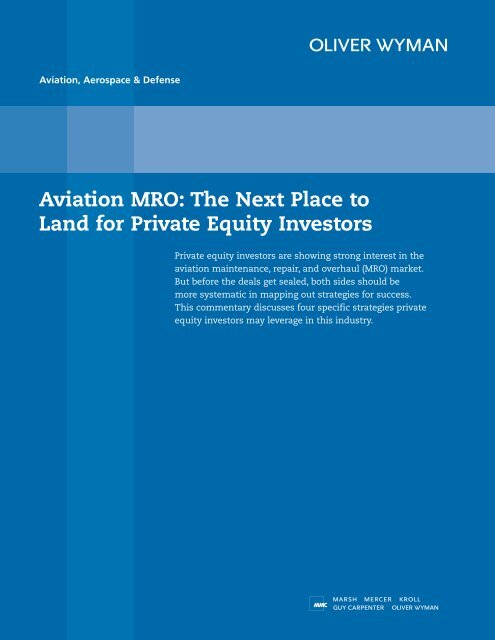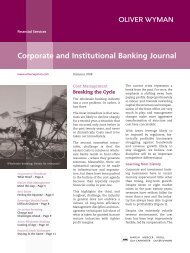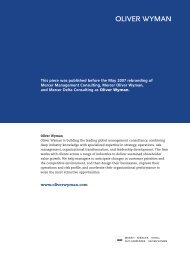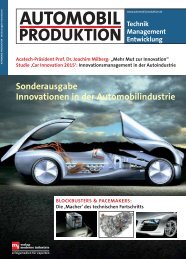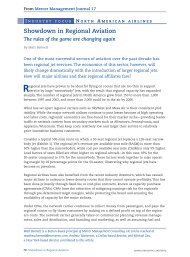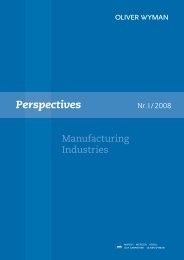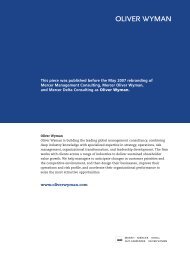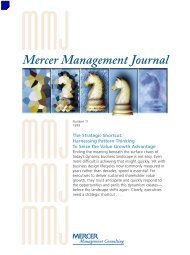Aviation MRO: The Next Place to Land for Private ... - PlaneStats
Aviation MRO: The Next Place to Land for Private ... - PlaneStats
Aviation MRO: The Next Place to Land for Private ... - PlaneStats
You also want an ePaper? Increase the reach of your titles
YUMPU automatically turns print PDFs into web optimized ePapers that Google loves.
<strong>Aviation</strong>, Aerospace & Defense<br />
<strong>Aviation</strong> <strong>MRO</strong>: <strong>The</strong> <strong>Next</strong> <strong>Place</strong> <strong>to</strong><br />
<strong>Land</strong> <strong>for</strong> <strong>Private</strong> Equity Inves<strong>to</strong>rs<br />
<strong>Private</strong> equity inves<strong>to</strong>rs are showing strong interest in the<br />
aviation maintenance, repair, and overhaul (<strong>MRO</strong>) market.<br />
But be<strong>for</strong>e the deals get sealed, both sides should be<br />
more systematic in mapping out strategies <strong>for</strong> success.<br />
This commentary discusses four specific strategies private<br />
equity inves<strong>to</strong>rs may leverage in this industry.
<strong>Private</strong> equity investing has been at the <strong>for</strong>efront<br />
of financial industry news in recent years, making<br />
headlines <strong>for</strong> the size and scope of deals. According<br />
<strong>to</strong> <strong>The</strong> Economist, in the first half of 2007 alone, acquisition<br />
activity worldwide <strong>to</strong>taled $2.7 trillion, much of<br />
which was funded through private equity investment.<br />
In previous months, however, the credit markets have<br />
been under enormous pressure, increasing the cost<br />
of debt financing and making deals more expensive.<br />
This has <strong>for</strong>ced private equity firms <strong>to</strong> under-leverage<br />
acquisitions by increasing the amount of equity,<br />
thus driving down acquisition prices. Nonetheless,<br />
with $300 billion <strong>to</strong> $400 billion still in the pipeline<br />
<strong>for</strong> financing, according <strong>to</strong> <strong>The</strong> Wall Street Journal, and<br />
with such significant deal flow at stake, private equity<br />
funds are not likely <strong>to</strong> slow their pace anytime soon.<br />
As part of this flurry of private equity activity, we<br />
have observed strong inves<strong>to</strong>r interest in the aviation<br />
<strong>MRO</strong> market. <strong>Private</strong> equity funds’ enthusiasm spans<br />
many geographic regions and all aspects of the <strong>MRO</strong><br />
value chain, and is matched by an equally strong<br />
interest on the part of industry participants. <strong>The</strong> <strong>MRO</strong><br />
industry is ripe <strong>for</strong> an infusion of private money, as<br />
several underlying characteristics make it broadly<br />
attractive <strong>to</strong> private equity inves<strong>to</strong>rs:<br />
• <strong>The</strong> market is large and has reliable growth<br />
prospects over the long term.<br />
• <strong>The</strong> industry needs investment <strong>to</strong> overcome fragmentation,<br />
which inhibits firms from meeting<br />
emerging cus<strong>to</strong>mer demands <strong>for</strong> global fulfillment<br />
networks and integrated, global service offerings.<br />
• Cost and operational per<strong>for</strong>mance have considerable<br />
room <strong>for</strong> improvement.<br />
Exhibit 1 Projected <strong>MRO</strong> commercial and military<br />
projects<br />
$ billions<br />
$70<br />
60<br />
50<br />
40<br />
30<br />
20<br />
10<br />
0<br />
$46.3<br />
$14.3<br />
$19.1<br />
$12.9<br />
Airframe<br />
Source: Oliver Wyman analysis.<br />
$59.2<br />
$17.2<br />
$26.7<br />
$15.2 $16.4<br />
Engine<br />
$65.4<br />
$20.0<br />
$29.0<br />
2008 2011 2013<br />
Components<br />
CAGR = 7.2%<br />
cent annually through 2013, <strong>to</strong> $65 billion, as shown in<br />
Exhibit 1. Because of a wave of industry restructuring<br />
and the emergence of numerous low-cost carriers that<br />
tend <strong>to</strong> minimize internally per<strong>for</strong>med maintenance,<br />
the level of outsourced <strong>MRO</strong> activity has reached 65<br />
percent, 62 percent, and 45 percent <strong>for</strong> engine, component,<br />
and airframe maintenance, respectively.<br />
<strong>MRO</strong> growth has been driven by two primary cus<strong>to</strong>mer<br />
trends—an increase in the size of the active fleet<br />
and the aging of the fleet—both of which contribute<br />
<strong>to</strong> higher <strong>to</strong>tal maintenance work requirements each<br />
year. In the past 35 years, the active fleet grew by 4.5<br />
percent a year on average <strong>for</strong> Western-type jets and<br />
3.6 percent a year on average <strong>for</strong> all aircraft, while the<br />
average age of the fleet more than doubled (Exhibit 2).<br />
• <strong>The</strong> industry has strong, steady cash flows and<br />
large asset pools, providing collateral <strong>for</strong> debt.<br />
Let’s consider each characteristic in more depth.<br />
A Large and Growing Market<br />
We estimate the current size of the global <strong>MRO</strong> market<br />
(excluding line maintenance) <strong>to</strong> be $46 billion, and<br />
expect the market <strong>to</strong> grow by an average of 7.2 per-<br />
Investment Needed <strong>to</strong> Overcome Fragmentation<br />
While large, the <strong>MRO</strong> industry remains fragmented,<br />
with roughly 60 percent of companies generating<br />
$100 million or less in revenues (Exhibit 3). <strong>The</strong> broad<br />
array of participants includes original equipment<br />
manufacturers (OEMs), independent repair providers,<br />
alternate parts (PMA) manufacturers, engineering<br />
services providers, and captive airline internal <strong>MRO</strong><br />
operations. Most non-airline industry participants<br />
2
Exhibit 2 Global fleet size and average age<br />
Fleet size<br />
60,000<br />
50,000<br />
40,000<br />
30,000<br />
20,000<br />
10,000<br />
13,925<br />
8<br />
22,947<br />
9.7<br />
34,821<br />
12.9<br />
43,759<br />
15.3<br />
Average age in years<br />
52,163<br />
16.4<br />
30<br />
25<br />
20<br />
15<br />
10<br />
5<br />
Fleet size<br />
CAGR = 3.6%<br />
<strong>MRO</strong> companies thus face the question of how <strong>to</strong><br />
grow their businesses <strong>to</strong> meet these quickly evolving<br />
demands. While it is possible <strong>for</strong> an <strong>MRO</strong> company <strong>to</strong><br />
grow organically by developing internal capabilities,<br />
this is a time-consuming process, and the company<br />
runs a high risk of lagging its more aggressive competi<strong>to</strong>rs.<br />
Outside investment, on the other hand, can<br />
provide the means <strong>for</strong> rapid scaling up or consolidation<br />
through mergers and acquisitions. Outside inves<strong>to</strong>rs<br />
also tend <strong>to</strong> bring a new focus <strong>to</strong> operational<br />
efficiency and cost structure that helps create value.<br />
Exhibit 4 Expected changes in <strong>MRO</strong> cus<strong>to</strong>mer<br />
preferences<br />
Percent of survey respondents<br />
0<br />
1970 1980 1990 2000 2007<br />
Russian aircraft Executive jets Western TPs<br />
0<br />
Western jets<br />
60%<br />
50<br />
55%<br />
51%<br />
Source: Oliver Wyman analysis.<br />
focus on a narrow set of capabilities or operate in a<br />
40<br />
limited set of regions.<br />
30<br />
29%<br />
29%<br />
Cus<strong>to</strong>mer preferences are shifting from regional providers<br />
who offer a la carte services <strong>to</strong> global fulfillment<br />
network providers offering integrated solutions.<br />
Recent Oliver Wyman research that surveyed more<br />
than 120 global <strong>MRO</strong> cus<strong>to</strong>mers and providers highlights<br />
this trend (Exhibit 4).<br />
20<br />
10<br />
0<br />
15%<br />
20%<br />
A la carte services Bundled services Total integration<br />
Exhibit 3 Distribution of <strong>MRO</strong> companies<br />
by revenue<br />
Source: Oliver Wyman 2007 <strong>MRO</strong> survey.<br />
2007 2010<br />
Room <strong>for</strong> Operational and Cost Improvement<br />
Over $2 billion<br />
Cost and per<strong>for</strong>mance improvement ef<strong>for</strong>ts in the<br />
Under $50 million<br />
<strong>MRO</strong> industry have been aggressive, but also rela-<br />
$501 million-<br />
$2 billion<br />
11%<br />
tively basic, notably headcount and labor rate reductions.<br />
Many <strong>MRO</strong> providers lag behind other heavy<br />
12%<br />
39%<br />
industries such as au<strong>to</strong>motive and aerospace in<br />
implementing programs that provide true cost and<br />
$100-$500 million<br />
17%<br />
21%<br />
per<strong>for</strong>mance differentiation. In addition, most <strong>MRO</strong><br />
providers lack the capital and expertise necessary <strong>to</strong><br />
implement sophisticated cost reduction and productivity<br />
enhancement programs, such as Continuous<br />
Improvement or Lean and Six Sigma.<br />
Source: Oliver Wyman 2007 <strong>MRO</strong> survey.<br />
$50-$100 million<br />
In 2007, Oliver Wyman’s annual <strong>MRO</strong> survey of airlines<br />
and <strong>MRO</strong> providers from around the world<br />
3
highlighted that only 18 percent of <strong>MRO</strong> participants<br />
have implemented disciplined, business-wide<br />
Continuous Improvement or Lean programs. Those<br />
that do operate such programs have seen average<br />
benefits (in cost reduction, turn-time improvement,<br />
and so on) in the range of 25 <strong>to</strong> 35 percent (Exhibit 5).<br />
Over the next few years, <strong>MRO</strong> companies that fail <strong>to</strong><br />
make these investments will likely be unable <strong>to</strong> compete<br />
with their more efficient peers.<br />
investment. <strong>The</strong>re are a number of reasons <strong>for</strong> this:<br />
• <strong>MRO</strong> firms typically have limited access <strong>to</strong> capital<br />
at attractive rates.<br />
• <strong>MRO</strong> management teams tend <strong>to</strong> be strong opera<strong>to</strong>rs<br />
but typically do not possess the deep experience<br />
with which <strong>to</strong> source, execute, and integrate<br />
capital investments.<br />
Strong Debt Collateral<br />
<strong>The</strong> <strong>MRO</strong> market is increasingly migrating <strong>to</strong> longterm<br />
contracts. As a result, the cash flow baseline<br />
of the typical <strong>MRO</strong> company is relatively stable and<br />
easily measured. Additionally, while many <strong>MRO</strong><br />
companies are privately owned, a sample of publicly<br />
traded data shows that hard assets typically represent<br />
at least 50 <strong>to</strong> 80 percent of enterprise value,<br />
and debt-<strong>to</strong>-equity ratios hover around 40 percent.<br />
With high asset levels, low long-term debt levels,<br />
and predictable cash flows based on long-term contracts,<br />
the typical <strong>MRO</strong> is poised <strong>for</strong> additional leverage<br />
and is an attractive candidate <strong>for</strong> private equity<br />
investment.<br />
Industry Acquisition Interest<br />
Not only is the <strong>MRO</strong> industry attractive <strong>to</strong> private equity<br />
inves<strong>to</strong>rs, our experience with the industry indicates<br />
that <strong>MRO</strong> executives are eager <strong>to</strong> consider such<br />
• Given the right offering, private equity investment<br />
could provide an <strong>MRO</strong> firm with the capability<br />
<strong>to</strong> leapfrog its competi<strong>to</strong>rs who continue <strong>to</strong> grow<br />
organically.<br />
• Airlines that operate large <strong>MRO</strong> businesses are<br />
increasingly seeking <strong>to</strong> divest non-core competencies<br />
such as maintenance. <strong>The</strong> sale of maintenance<br />
operations offers a more compelling means<br />
of creating value than simple outsourcing. <strong>The</strong><br />
spin-off of Air Canada Technical Services by Air<br />
Canada and subsequent sale <strong>to</strong> KKR/Sageview is<br />
representative of this trend.<br />
<strong>The</strong> access <strong>to</strong> capital, deal expertise, and four- <strong>to</strong><br />
eight-year investment horizon of most private equity<br />
funds make a natural match with the attractive<br />
growth opportunities and competencies of <strong>to</strong>day’s<br />
<strong>MRO</strong> companies.<br />
Exhibit 5 <strong>MRO</strong> implementation of Lean and Continuous Improvement and associated results<br />
Level of implementation of<br />
Lean/Continuous Improvement activities<br />
% of survey respondents<br />
Per<strong>for</strong>mance improvement based on implementation of<br />
Lean/Continuous Improvement activities<br />
% of survey respondents that have implemented activities<br />
Disciplined,<br />
business-wide<br />
deployment<br />
18%<br />
No activity in<br />
any <strong>for</strong>m<br />
Over 75%<br />
10%<br />
0 -10%<br />
23%<br />
51 - 75%<br />
14%<br />
21%<br />
22%<br />
Some level of<br />
activity<br />
36%<br />
24%<br />
30%<br />
Contemplated<br />
and planned but<br />
not yet initiated<br />
26 - 50%<br />
11 - 25%<br />
Average improvement of 25-35%<br />
Note: Per<strong>for</strong>mance improvement percentages are a composite of improvements in: reduction in inven<strong>to</strong>ry, increase in labor productivity, improvement in on-time<br />
per<strong>for</strong>mance, reduction in rework, reduction in cycle time, reduction in floor space, and increase in capacity.<br />
Source: Oliver Wyman 2007 <strong>MRO</strong> survey.<br />
4
Exhibit 6 Four strategies <strong>for</strong> enhancing the value of <strong>MRO</strong> investments<br />
Vertical integration<br />
Horizontal integration<br />
Geographic expansion/<br />
global network<br />
Cost and per<strong>for</strong>mance<br />
improvement<br />
• Broader integration of parts<br />
manufacturing (OEM or PMA) and<br />
repair provisioning/<br />
development<br />
• Expanded capabilities across fleets<br />
or repair plat<strong>for</strong>ms<br />
• Expanded value-added services<br />
such as maintenance programs<br />
and supply chain services<br />
• Leverage global labor markets<br />
• Regional <strong>to</strong>uch with cus<strong>to</strong>mers<br />
• Centralized knowledge centers<br />
• Simple and effective way <strong>to</strong><br />
quickly return value <strong>to</strong> inves<strong>to</strong>rs<br />
• Dramatic improvements through<br />
Lean and Continuous Improvement<br />
Note: Past per<strong>for</strong>mance is not a guarantee of future results.<br />
Enhancing the Value of <strong>MRO</strong> Investments<br />
Although private equity inves<strong>to</strong>rs and <strong>MRO</strong> companies<br />
clearly could benefit from working <strong>to</strong>gether,<br />
certain strategies could enable these deals <strong>to</strong> produce<br />
even more attractive returns. We’ve identified four<br />
promising strategies: vertical integration, horizontal<br />
integration, geographic expansion, and a focus on<br />
cost/productivity improvement.<br />
Vertical integration of parts and repair. Until recently,<br />
only OEMs could offer combined parts manufacturing<br />
and parts repair services. <strong>The</strong> emergence<br />
of large PMA companies, however, has opened this<br />
strategy up <strong>to</strong> <strong>MRO</strong> businesses. A combined PMA-<br />
<strong>MRO</strong> company would be able <strong>to</strong> provide a more integrated<br />
offering <strong>to</strong> its cus<strong>to</strong>mers and take on greater<br />
levels of deal risk com<strong>for</strong>tably, including scrap risk<br />
and removal risk. <strong>The</strong> use of alternate parts is gaining<br />
acceptance among carriers and leasing companies<br />
globally, and some industry analysts believe that Pratt<br />
& Whitney’s entry in<strong>to</strong> CFM56-3 parts manufacturing<br />
will act as a tipping point <strong>for</strong> even wider acceptance.<br />
Consolidation of repair facilities (including designated<br />
engineering repair) and parts manufacturers could<br />
create considerable value and legitimate competition<br />
in the growing integrated “cost-per-hour” segment of<br />
the <strong>MRO</strong> market.<br />
Horizontal integration of maintenance scope.<br />
Substantial opportunities exist <strong>to</strong> consolidate several<br />
<strong>MRO</strong> providers with different capability sets, such<br />
as different fleet focus and different Air Transport<br />
Association of America chapter focus, and thereby<br />
meet the growing demands of cus<strong>to</strong>mers <strong>for</strong> integrated<br />
maintenance offerings. Such consolidation<br />
could take various <strong>for</strong>ms, such as the expansion of<br />
repair capabilities across repair plat<strong>for</strong>ms or fleets<br />
in the component space, or consolidating engineering<br />
or maintenance program providers with airframe<br />
overhaul providers <strong>to</strong> optimize the scope of work and<br />
lower the <strong>to</strong>tal cost of fleet ownership.<br />
Geographic expansion. A globalized <strong>MRO</strong> could<br />
deliver enhanced value through a combination of<br />
local presence, a centralized knowledge base, and a<br />
global multi-skilled labor <strong>for</strong>ce at a broad range of<br />
labor rates. Such a company would be better able <strong>to</strong><br />
service larger international airlines, more efficiently<br />
employ varied labor pools around the world, and<br />
leverage knowledge and skills across facilities.<br />
Cost and per<strong>for</strong>mance improvement. Sophisticated<br />
cost and per<strong>for</strong>mance improvement programs can be<br />
implemented alone or in combination with the strategies<br />
cited earlier. As discussed, <strong>MRO</strong>s often lack the<br />
capital or expertise <strong>to</strong> effectively implement these<br />
programs broadly across their enterprises. External<br />
investment can provide a plat<strong>for</strong>m from which <strong>to</strong><br />
build out these capabilities, particularly across a larger<br />
firm offering a more diverse set of capabilities.<br />
* * *<br />
Despite the recent turmoil in the credit markets,<br />
there is still significant private equity opportunity<br />
in the <strong>MRO</strong> market. <strong>Private</strong> equity investment that<br />
effectively executes one of the fundamental strategies<br />
has the potential <strong>to</strong> provide substantial returns, as<br />
well as <strong>to</strong> reshape the <strong>MRO</strong> industry. <strong>The</strong> <strong>MRO</strong> market<br />
is poised <strong>for</strong> trans<strong>for</strong>mation, in terms of both consolidation<br />
and per<strong>for</strong>mance improvement, and private<br />
equity investment will no doubt act as a catalyst.<br />
5
<strong>The</strong> <strong>Aviation</strong>, Aerospace & Defense Practice<br />
Oliver Wyman’s <strong>Aviation</strong>, Aerospace & Defense<br />
practice works with OEMs, commercial passenger<br />
and cargo carriers, <strong>MRO</strong>s, other service providers,<br />
and government entities <strong>to</strong> develop and implement<br />
business growth strategies, improve operational<br />
efficiencies, and maximize organizational effectiveness.<br />
We have successfully completed a broad array<br />
of engagements <strong>for</strong> aviation, aerospace, and defense<br />
clients over the past five years, and have consulted<br />
<strong>to</strong> nearly three quarters of the Fortune 500 firms in<br />
these sec<strong>to</strong>rs. We serve the industry worldwide with<br />
consultants based in North America, Asia, Europe,<br />
and the Middle East.<br />
For more in<strong>for</strong>mation, please contact:<br />
Roger Lehman, <strong>Aviation</strong> practice leader. He can be<br />
reached at roger.lehman@oliverwyman.com.<br />
Capital Markets Capabilities<br />
Oliver Wyman’s Capital Markets’ capabilities span<br />
a range of services <strong>to</strong> support private equity funds,<br />
hedge funds, investment banks, commercial banks,<br />
arrangers, strategic inves<strong>to</strong>rs, and insurers. Our professionals<br />
focus on reducing the risks and increasing<br />
the speed and probability of success of our clients’<br />
investment decisions.<br />
With substantial experience in operational and strategic<br />
consulting <strong>to</strong> the <strong>MRO</strong> industry and an extensive<br />
suite of support services <strong>for</strong> capital markets<br />
clients, Oliver Wyman can work with both PE and<br />
<strong>MRO</strong> firms <strong>to</strong> develop approaches that maximize the<br />
value of such investments.<br />
For more in<strong>for</strong>mation, please contact:<br />
Allan Kaulbach, Capital Markets practice<br />
leader <strong>for</strong> Manufacturing, Transportation,<br />
and Energy. He can be reached at<br />
allan.kaulbach@oliverwyman.com.<br />
Oliver Wyman’s capital markets consulting services<br />
Inves<strong>to</strong>r services<br />
Investment<br />
hypotheses<br />
Market<br />
scanning<br />
Due<br />
diligence<br />
Valuation<br />
Portfolio<br />
company<br />
analysis<br />
Remediation<br />
(negotiation,<br />
litigation<br />
support)<br />
Exit strategies<br />
Regulated services<br />
Capital raise (IPO,<br />
private placement)<br />
Acquisition<br />
Spin-offs,<br />
divestment<br />
activities<br />
Work with<br />
“regulated fee”<br />
arrangements<br />
Basic consulting services<br />
Broker/dealer services 1<br />
Portfolio company services<br />
Operational cost<br />
reduction and<br />
sourcing<br />
Value<br />
proposition<br />
reinvention<br />
Pricing/<br />
sales <strong>for</strong>ce<br />
effectiveness<br />
Postmerger<br />
integration<br />
Integration<br />
and Lean<br />
activities<br />
Organizational<br />
redesign and<br />
rationalization<br />
Matter<br />
specific<br />
financial<br />
advisory<br />
Investment<br />
harvest<br />
1 Oliver Wyman Transaction Services is a division of MMC Securities Corp. (“MMCSC”) member FINRA/SIPC. Oliver Wyman and OWTS are<br />
affiliates under common ownership. MMCSC products, and services are offered only in the US by MMCSC, a US registered broker/dealer and<br />
member of FINRA/SIPC. Main Office: 1166 Avenue of the Americas, New York, NY 10036. Phone: 201-284-3614.<br />
6
About Oliver Wyman<br />
With more than 2,500 professionals in over 40 cities around the globe, Oliver Wyman is the<br />
leading management consulting firm that combines deep industry knowledge with specialized<br />
expertise in strategy, operations, risk management, organizational trans<strong>for</strong>mation,<br />
and leadership development. <strong>The</strong> firm helps clients optimize their businesses, improve<br />
their operations and risk profile, and accelerate their organizational per<strong>for</strong>mance <strong>to</strong> seize<br />
the most attractive opportunities. Oliver Wyman is part of Marsh & McLennan Companies<br />
[NYSE: MMC]. For more in<strong>for</strong>mation, visit www.oliverwyman.com.<br />
This commentary was prepared by Chris Spaf<strong>for</strong>d, Roger Lehman, and Tim Hoyland,<br />
Dallas-based direc<strong>to</strong>rs in the <strong>Aviation</strong> practice. <strong>The</strong>y can be reached at:<br />
chris<strong>to</strong>pher.spaf<strong>for</strong>d@oliverwyman.com, roger.lehman@oliverwyman.com, and<br />
tim.hoyland@oliverwyman.com. Kyle Smith and Reid Grandle of the Dallas<br />
office contributed <strong>to</strong> this commentary.<br />
www.oliverwyman.com<br />
Copyright © Oliver Wyman. All rights reserved.


